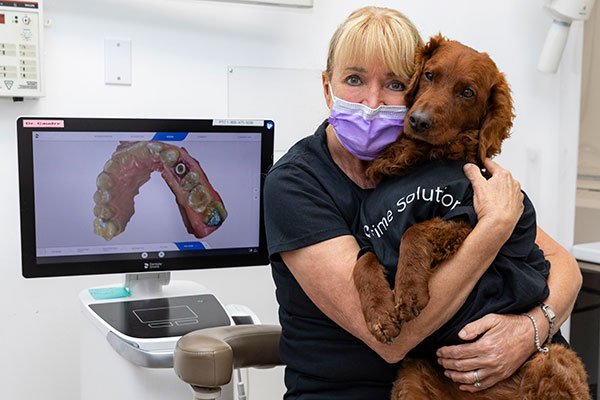Has it been a decade-or several decades-since you last visited the dentist? Did your first dental implant procedure occur in the 1990s or earlier? If so, you surely underwent a different sort of dental procedure than anyone who visited their oral surgeon, periodontist, or dentist in the present age.
You might remember lengthy procedures, unconvincing and poorly placed implants, and more. Thanks to the wonders of computer-guided surgery, however, the process and results have improved dramatically.
What makes computer-guided surgery so extraordinary? Let Dr. Suzanne Caudry and her dream team of staff fill you on the wonders of these computer-guided processes. Having operated at the forefront of periodontal innovation for so long, we think there is no one better suited to educate you than our team.
Read at your leisure-and if any questions arise, be sure to contact us at (416) 928-3444 today.
Learn More Today.All About Computer-Guided Surgery
The fields of periodontics and oral surgery have come a long way. For thousands of years, people have devised dental implants out of a variety of materials, and they have deployed countless methods. The end-results have varied, and there is no doubt that primitive procedures were not the easiest to endure. In the modern world, however, patients can rest easy knowing that their dental implant surgery will be as painless and swift as can be.
The term 'Digital Dentistry' conjures up many things for people for the first time-some of which are accurate, some of which are not. Dental practices that incorporate high-tech, computer-controlled, or digital components are considered digital dentistry as opposed to dental practices that use traditional, low-tech components.
A practice that embraces this technology, often referred to as 'digital workflows,' might utilize CAD/CAM (computer-aided design/computer-aided manufacturing). Some of the work that might fall under the umbrella of computer-aided technology includes, but is not limited to:
- Smile design
- Intraoral radiographs or CBCT scans
- Intraoral photography
- Laser technology
With the use of digital workflows, oral surgeons are able to maximize the success of implant procedures. Using intraoral scanners and imaging software, we can plan out all aspects of your dental implant surgery after your initial preparation session. Before the surgery, we can even walk you through the entire implant placement process.
Using intraoral scanners and a state-of-the-art CBCT scanner, we scan your teeth, gums, and jaw during the first stage of our digital dental implant procedure. Following retrieval of legible scans, we merge the two images together to create a vivid picture of your mouth. This composite image serves as a guide during surgery.
Once all the necessary preliminary work has been performed, we move forward with the computer-guided surgical process. We rely on digital workflows and years of unrivaled professional experience to give you the results we promised. No patient should ever settle for anything less than the best.
Digital Workflows Benefit the Patient
Oral surgeons benefit from digital implantology more than simply simplifying surgical processes. These procedures, like all advances we embrace, benefit the patient equally, if not more so than anything else. We prioritize patient-centered care above all else. Our innovations and modifications are always centered around the patient. As a result, we can ensure that we meet the specific needs of all of our patients.
Accurate Dental Implant Placement
When discussing dental implant surgery, accuracy is often a concern. A correctly placed implant safeguards patients from countless problems, including gum infections, implant loss, and aesthetic problems. No one wants to go through a dental implant procedure only to leave with a poorly placed dental implant.
Computer-guided oral procedures enable the professionals to craft surgical processes step-by-step, leveraging tools like intraoral scanners and CBCT scans. By anticipating every detail of the procedure in advance, you can rest easy knowing that you will get the results you desire. Time after time, patients leave with a great smile they didn't think possible. In reality, a periodontist is revealing the smile that the patient had all along.
At the facilities of Dr. Caudry, we make sure your new teeth fit your mouth perfectly, from the implant to the crown. While that may sound like a big promise, we do not believe it is too much for our patients to ask. As a patient, you should expect your standards to be high. We strive to meet and exceed those expectations.
Dental Impressions Done Right
The incorporation of digital workflows has done more than improve surgical processes. Through the wonders of modern technology, we have perfected the practice of taking dental impressions. We eliminate any awkwardness or discomfort associated with traditional putty-like alginate that most dentists use for this purpose; instead, we utilize handheld intraoral scanners to accurately and vividly capture images of teeth and gums. This makes the dental impression process as streamlined and comfortable as a regular check-up.
In practices like ours, the integration of digital workflows has made great strides. To us, the patient's comfort is of the utmost importance. It has not only improved the efficiency of surgical methods, but it has greatly improved the overall patient experience. A piece of equipment that hinders our patients' time in the dentist's chair would never be integrated.
Dental impressions are a major part of the dental implant placement process. More than just a preliminary measure, dental impressions act as the foundation for the planning process. Improper planning leads to unsatisfactory results-and who wants that?
Learn More About Dental Implants Today
As you can see, the incorporation of digital workflows into the worlds of periodontics and oral surgery has radically transformed the overall patient experience. From the consultation process to the placement of the implant and after-care, these modern-day approaches ensure added comfort, better results, and so much more.
Look to us when the time comes to learn more about computer-guided surgery and the work we can do. We can answer questions, offer our services, and more. Call (416) 928-3444 at your convenience.

